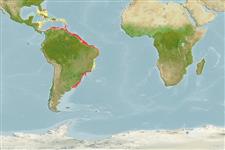| Native range | All suitable habitat | Point map | Year 2050 |

|
| This map was computer-generated and has not yet been reviewed. |
| Micropogonias furnieri AquaMaps Data sources: GBIF OBIS |
Issue
The species Micropogonias opercularis (Quoy & Gaimard, 1825) is considered as valid in Eschmeyer (CofF ver. Jul. 2010: Ref. 84883) according to López et al. (2002: Ref. 80900).